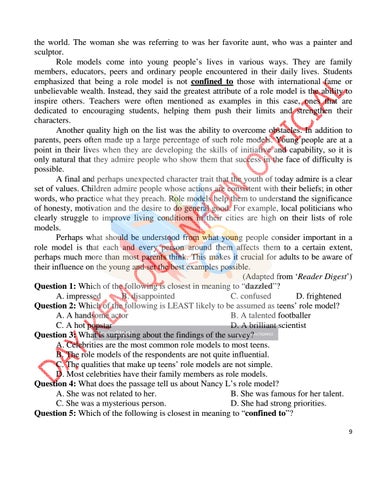the world. The woman she was referring to was her favorite aunt, who was a painter and sculptor. Role models come into young people’s lives in various ways. They are family members, educators, peers and ordinary people encountered in their daily lives. Students emphasized that being a role model is not confined to those with international fame or unbelievable wealth. Instead, they said the greatest attribute of a role model is the ability to inspire others. Teachers were often mentioned as examples in this case, ones that are dedicated to encouraging students, helping them push their limits and strengthen their characters. Another quality high on the list was the ability to overcome obstacles. In addition to parents, peers often made up a large percentage of such role models. Young people are at a point in their lives when they are developing the skills of initiative and capability, so it is only natural that they admire people who show them that success in the face of difficulty is possible. A final and perhaps unexpected character trait that the youth of today admire is a clear set of values. Children admire people whose actions are consistent with their beliefs; in other words, who practice what they preach. Role models help them to understand the significance of honesty, motivation and the desire to do general good. For example, local politicians who clearly struggle to improve living conditions in their cities are high on their lists of role models. Perhaps what should be understood from what young people consider important in a role model is that each and every person around them affects them to a certain extent, perhaps much more than most parents think. This makes it crucial for adults to be aware of their influence on the young and set the best examples possible. (Adapted from ‘Reader Digest’) Question 1: Which of the following is closest in meaning to “dazzled”? A. impressed B. disappointed C. confused D. frightened Question 2: Which of the following is LEAST likely to be assumed as teens’ role model? A. A handsome actor B. A talented footballer C. A hot popstar D. A brilliant scientist Question 3: What is surprising about the findings of the survey? A. Celebrities are the most common role models to most teens. B. The role models of the respondents are not quite influential. C. The qualities that make up teens’ role models are not simple. D. Most celebrities have their family members as role models. Question 4: What does the passage tell us about Nancy L’s role model? A. She was not related to her. B. She was famous for her talent. C. She was a mysterious person. D. She had strong priorities. Question 5: Which of the following is closest in meaning to “confined to”? 9
ĐỀ CHÍNH THỨC VÀ ĐỀ XUẤT KÌ THI HSG KHU VỰC DUYÊN HẢI VÀ ĐỒNG BẰNG BẮC BỘ MÔN TIẾNG ANH KHỐI 11

Issuu converts static files into: digital portfolios, online yearbooks, online catalogs, digital photo albums and more. Sign up and create your flipbook.